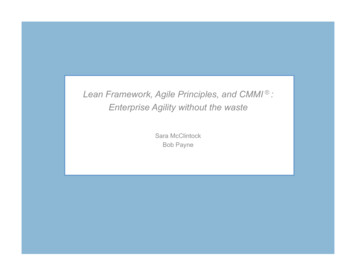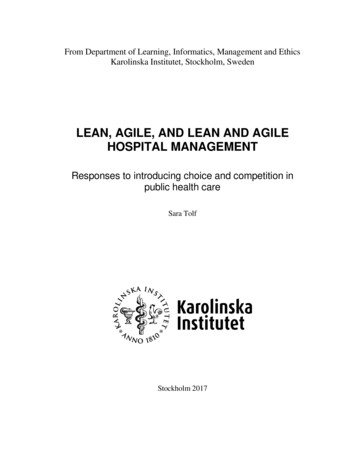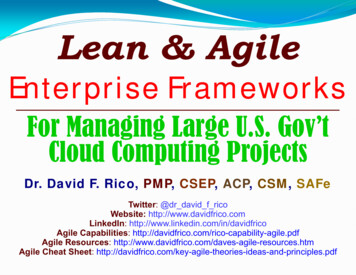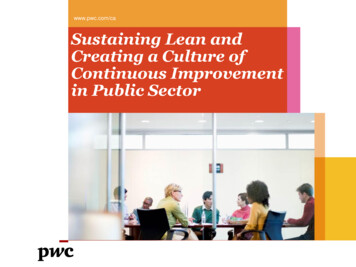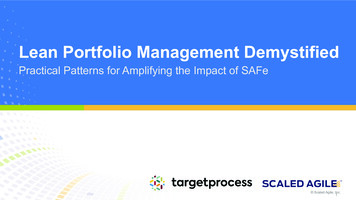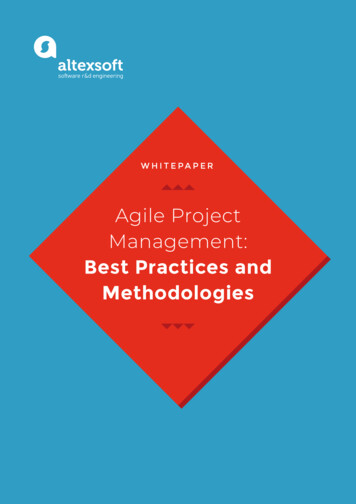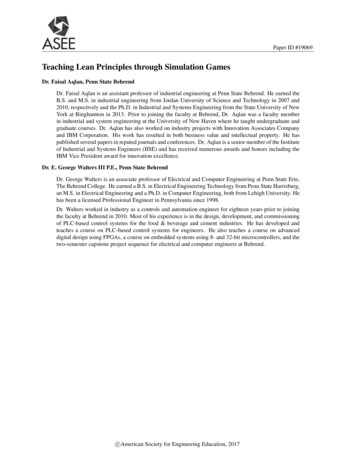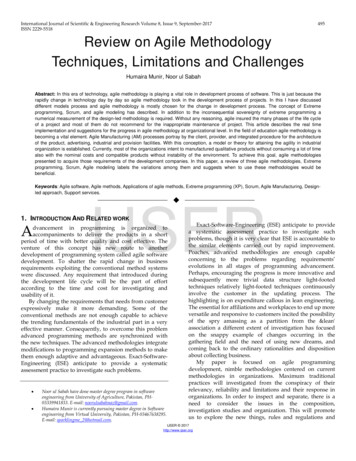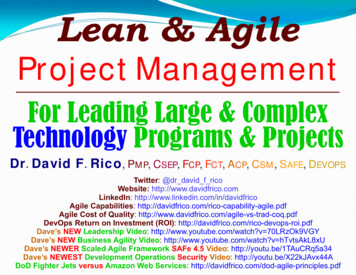
Transcription
Lean & AgileProject ManagementFor Leading Large & ComplexTechnology Programs & ProjectsDr. David F. Rico, P MP, C SEP, F CP, F CT, A CP, C SM , S AFE , D EVOPSTwitter: @dr david f ricoWebsite: http://www.davidfrico.comLinkedIn: http://www.linkedin.com/in/davidfricoAgile Capabilities: le Cost of Quality: Ops Return on Investment (ROI): http://davidfrico.com/rico-devops-roi.pdfDave’s NEW Leadership Video: http://www.youtube.com/watch?v 70LRzOk9VGYDave’s NEW Business Agility Video: http://www.youtube.com/watch?v hTvtsAkL8xUDave’s NEWER Scaled Agile Framework SAFe 4.5 Video: http://youtu.be/1TAuCRq5a34Dave’s NEWEST Development Operations Security Video: http://youtu.be/X22kJAvx44ADoD Fighter Jets versus Amazon Web Services: http://davidfrico.com/dod-agile-principles.pdf
Author Background Gov’t contractor with 35 years of IT experienceB.S. Comp. Sci., M.S. Soft. Eng., & D.M. Info. Sys.Large gov’t projects in U.S., Far/Mid-East, & Europe Career systems & software engineering methodologist Lean-Agile, Six Sigma, CMMI, ISO 9001, DoD 5000 NASA, USAF, Navy, Army, DISA, & DARPA projects Published seven books & numerous journal articles Intn’l keynote speaker, 200 talks to 14,500 people Specializes in metrics, models, & cost engineering Cloud Computing, SOA, Web Services, FOSS, etc. Professor at 7 Washington, DC-area universities2
Project Management — von MoltkeNO BATTLE PLANEVER SURVIVESFIRST CONTACTWITH THE ENEMY(Because Humans CannotSee Beyond the First Battle)— Helmuth von Moltkethe Elder ( 1871)3
Today’s WHIRLWIND ENVIRONMENTGlobalCompetitionWork LifeImbalanceVagueRequirements Overruns Attrition Escalation Runaways nizationDownsizingSystemComplexityReducedIT Budgets81 MonthCycle TimesRedundantData CentersObsoleteTechnology & Skills Inefficiency High O&M Lower DoQ Vulnerable N-M BreachLack ofInteroperabilityOverburdeningLegacy SystemsPoorIT SecurityPine, B. J. (1993). Mass customization: The new frontier in business competition. Boston, MA: Harvard Business School Press.Pontius, R. W. (2012). Acquisition of IT: Improving efficiency and effectiveness in IT acquisition in the DoD. Second AnnualAFEI/NDIA Conference on Agile in DoD, Springfield, VA, USA.4
Large TRADITIONAL UCTIVITYSize vs. Change24%16%8%026251000%40025Size vs. Success4.0048%3.002.001.0026Size vs. ze vs. ZEJones, C. (1991). Applied software measurement: Assuring productivity and quality. New York, NY: McGraw-Hill.5
Large TRADITIONAL s47%Other 7%Always 7%Implementation18%Often 13%Design28%Sometimes16%IT PROJECT FAILURESGLOBAL IT PROJECT 00026%199627%0%16%46% 1.123% 0.728%33%40% 1.415%49% 0.440%53%20%18%51%28% 1.819%53%34%1998199446%29%Rarely19%31%60%80%100% 0.02002 2003 2004 2005 2006 2007 2008 2009 20106
What is AGILE PROJECT MGT.? A-P-M (ā-pē-ĕm): Light, flexible, collaborative, andadaptive; Market-centric project management model: Sound, yet flexible process to manage projects using leanthinking, product development flow, & agile methods Adaptable framework for customer collaboration, teamwork, iterative development & responding to change Use of evolutionary, incremental, and iterative deliverymethods to converge on an optimal customer solution Lightweight, yet disciplined project management modelfor building high-quality technology-intensive systems Maximizing BUSINESS VALUE with right sized, justenough, and just-in-time products and service projectsAugustine, S. (2005). Managing agile projects. Upper Saddle River, NJ: Pearson Education.Chin, G. (2004). Agile project management: How to succeed in the face of changing project requirements. Broadway, NY: Amacom.DeCarlo, D. (2004). Extreme project management: Using leadership, principles, and tools to deliver value in the face of volatility. San Francisco, CA: Jossey-Bass.Highsmith, J. A. (2010). Agile project management: Creating innovative products. Boston, MA: Pearson Education.7
Values of AGILE PROJECT MGT. Declaration of Interdependence formed in 2005Carved out a niche for agile project managersFocus on Agile Methods, ROI, and culture We increase ROI by making continuous flow of value our focus. We deliver reliable results by engaging customers in frequentinteractions and shared ownership. We expect uncertainty and manage for it through iterations,anticipation, and adaptation. We unleash creativity and innovation by recognizing thatindividuals are the ultimate source of value. We create an environment where people can make a difference. We boost performance through group accountability for resultsand shared responsibility for team effectiveness. We improve effectiveness and reliability through situationallyspecific strategies, processes and practices.DOI. (2005). Declaration of interdependence. Retrieved April 8, 2014, from http://www.pmdoi.org8
Goals of AGILE PROJECT MGT. Traditional project management is scope-basedAgile project management is primarily time-basedEarly, iterative, & release of valuable features is #1Sylvester, T. (2013). Waterfall, agile, and the triple constraint. Retrieved December 16, 2017, from e-the-triple-constraint9
Place of AGILE PROJECT MGT. “Agility” has many dimensions other than ITIt ranges from leadership to technological agilityThe focus of this brief is program management agilityAgile LeadersAgile Organization ChangeAgile Acquisition & Contracting Agile Strategic PlanningAgile Capability Analysis Agile Program ManagementAgile Project ManagementAgile Systems DevelopmentAgile Processes & PracticesAgile ToolsAgile Information SystemsAgile Tech.10
Models of AGILE PROJECT MGT. Dozens of Agile project management models emergedMany stem from principles of Extreme ProgrammingVision, releases, & iterative development commonRADICAL- 2002 -EXTREME- 2004 -ADAPTIVE- 2010 -AGILE- 2010-SIMPLIFIED APM- 2011 - Conceptualize Visionate Scoping Envision Vision Feasibility Speculate Planning Speculate Roadmap Planning Innovate Feasibility Explore Release Plan Tracking Re-Evaluate Cyclical Dev. Iterate Sprint Plan Reporting Disseminate Checkpoint Launch Daily Scrum Review Terminate Review Close RetrospectiveThomsett, R. (2002). Radical project management. Upper Saddle River, NJ: Prentice-Hall.DeCarlo, D. (2004). Extreme project management: Using leadership, principles, and tools to deliver value in the face of volatility. San Francisco, CA: Jossey-Bass.Wysocki, R.F. (2010). Adaptive project framework: Managing complexity in the face of uncertainty. Boston, MA: Pearson Education.Highsmith, J. A. (2010). Agile project management: Creating innovative products. Boston, MA: Pearson Education.Layton, M. C., & Maurer, R. (2011). Agile project management for dummies. Hoboken, NJ: Wiley Publishing.11
APM Model—RADICAL Created by Rob Thomsett at Cutter in 2002Focus is on scoping, economics, and planningCost/benefit-driven project management approachRadical Project ManagementDefineProjectConcept &SuccessCriteriaDetermineProjectScope &ObjectivesAnalyze RisksDevelopProjectTask mProjectPostImplementationReviewsTrack &ReportProjectProgressAnalysisProjectCosts &BenefitsAllocateProjectPeople jectTasks &BudgetThomsett, R. (2002). Radical project management. Upper Saddle River, NJ: Prentice-Hall.12
APM Model—EXTREME Created by Doug DeCarlo at Cutter in 2004Focus is on collaboration, scoping, and speedThinner traditional project management minateSponsor’s VisionPlanning MeetingLearning by DoingBusiness QuestionsProduct Launch Interview Sponsor Describe Objectives Collective Vision Size Deliverables SCORE Model Architecture Who Needs It? What Will It Take? Acceptance Testing Documentation Project Prospectus Business Questions Map Schedule Choose Life Cycle Development Construction Can We Get It? Is It Worth It? Support Plan Maintenance Plan Requirements ID’d Development Tools Testing Time Boxing Risk Planning Trial and Error CollaborationCollective Vision Scope Meeting Future Scenarios Project Skinny Project Boundaries Project Vision Win Conditions Benefit Map Wow Factor Uncertainty ProfileCollective VisionSelect Core TeamPost Meeting PM Infrastructure Financial Goals Benefit Plan Partner AgreementsGenerate Results Visibility Early ValueProject Review Check Performance Check Schedule Check Costs Check Benefits Check Project ROI Go/No-Go Decision Fast FailuresStabilization Training/Education Utilization Performance Feedback Corrective ActionProject ChangesBusiness QuestionsBusiness Questions Go/No-Go Decision Modify Questions Re-Direct As-Needed Update VisionUpdate Prospectus Update Stakeholders Re-examine TeamUpdate Prospectus Deploy Solution Customer ServiceLessons LearnedTeam RewardsTrack BenefitsDeCarlo, D. (2004). Extreme project management: Using leadership, principles, and tools to deliver value in the face of volatility. San Francisco, CA: Jossey-Bass.13
APM Model—ADAPTIVE Created by Bob Wysocki for consulting in 2010Designed to be a generic model for non-IT projectsLightweight traditional project management approachAdaptive Project w Identify Opportunity Develop CoS Identify Project Type Prioritize Constraints Develop Prototype Reprioritize Needs Analyze Needs Evaluation Solution Finalize Documents Lessons Learned Write PoS Document Needs Stage Gate 1 Review Develop WBS Team Formation Detailed WBS Estimate Resources Estimate Value Determine Success Process Changes Final Report Stage Gate 2 Review Stage Gate 3 Review Stage Gate 4 Review Stage Gate 5 ReviewCyclical Product or Service ImplementationCycle PlanningProduct or Service ImplementationDaily MeetingsCycle Reviews Responsibilities Timelines Select Personnel with Needed Skills Identify Detailed Technical Tasks Arrange Facilities Prepare Agendas Update Requirements Update Scope Work Packages Communications Create Detailed Architectures and Designs Select and Implement Technical Solutions Send Meeting Notices Facilitate Meetings Update Schedules Update Plans Governance Perform Development and Operational Tests Record Action Items Inform StakeholdersContinuous Improvement Continually improve process, documents, team, architecture, designs, implementation, tests, etc.Stage Gate 3.nReviewWysocki, R.F. (2010). Adaptive project framework: Managing complexity in the face of uncertainty. Boston, MA: Pearson Education.14
APM Model—AGILE Created by Jim Highsmith of Cutter in 2010Front-end visions and architectures and final QALight project model wrapped around agile practicesInnovation LifecycleEnvisionSpeculateExplore Product Vision Product Architecture Gather Requirements Product Backlog Iteration Management Technical Practices Final Review Final Acceptance Clean Up Open Items Support Material Project Objectives Project Community Delivery Approach Release Planning Risk Planning Team Development Team Decisions Collaboration Final QA Final Documentation Final Retrospective Final Reports Final Deployment Project Celebration Cost EstimationLaunchCloseIterative DeliveryTechnical PlanningDevelopment, Test, & EvaluationOperational TestingAdapt Story Analysis Task Development Development Pairing Unit Test Development Integration Testing System Testing Focus Groups Technical Reviews Task Estimation Task Splitting Task Planning Simple Designs Coding and Refactoring Operational Testing Usability Testing Team Evaluations Project Reporting Unit and Component Testing Acceptance Testing Adaptive ActionContinuous Standups, Architecture, Design, Build, Integration, Documentation, Change, Migration, and IntegrationStory DeploymentHighsmith, J. A. (2010). Agile project management: Creating innovative products. Boston, MA: Pearson Education.15
APM Model—SIMPLIFIED Created by Mark Layton at PlatinumEdge in 2011Mix of new product development, XP, and ScrumSimple codification of common XP-Scrum hybridLayton, M. C., & Maurer, R. (2011). Agile project management for dummies. Hoboken, NJ: Wiley Publishing.16
Simplified APM—VISION Description. Product goals aligned with strategyOwner. Product OwnerFrequency. At least annually [1-2 hours]Process Steps1. Develop product objective.2. Create draft visionstatement.3. Validate and revise visionstatement.4. Finalize vision statement.Vision For. target customer Who. needs it The. product name Is a. product category That. product benefit, reason to buy Unlike. competitors Our product. differentiator, value added Example For. Bank customers Who. Want mobile banking The. Mobile banking application Is a. Mobile device enable banking app That. Provides secure, 24x7 mobile banking Unlike. Brick-and-mortar access points Our product. Enable 24-hour a day servicesProduct owner identifies product vision. Vision is project's destination. It defines what productis, how it supports organization strategy, who will use it, and why people will use it.17
Simplified APM—ROADMAP Description. Holistic view of product featuresOwner. Product OwnerFrequency. At least biannually [2-4 hours]Process Steps1. Identify product features.2. Arrange product features.FeaturesAccountStatus Open acct. Modify acct. Close acct. Login Balances Statements3. Estimate and order productfeatures.4. Determine high-level timeframes.Transaction Deposit Withdrawal roduct owner creates product roadmap. Roadmap is high-level view of product requirementswith loose timeframe for development. Identify, estimate, valuate, prioritize, and schedule themes.18
Simplified APM—RELEASE PLAN Description. Release timing for product functionsOwner. Product OwnerFrequency. At least quarterly [4-8 hours]Process StepsDecomposition1. Decompose product features.Account2. Create release plan. Establish release goal.Open Create Login Setup Refine user stories. Verify release plan. Password Address TypeClose Notify Refund RationaleRelease Plan Prioritize or order user stories. Set release date.ModifySprint 1 Story 1 Story 11Sprint 2Sprint 3Release 1 Story 1 Story 11 Story 1 Story 11 Story 1 Story 11Product owner creates release plan. Release plan identifies high-level timetable for releasingfunctions. Mid-term goals that team mobilizes around. There are many releases in priority order.19
Simplified APM—SPRINT PLAN Description. Specific iteration goals and tasksOwner. Product Owner and Development TeamFrequency. At the start of each sprint [2-4 hours]Process Steps1. Establish goals and chooseuser stories.2. Decompose stories into tasksand create sprint backlog.Goals & User StoriesAs a mobile banking customer, I want to createan account so I can write personal checks Create account. Login to account. Setup checking account.Sprint BacklogTaskPri Create account: oeJoeJoe-MTWT F440000440000008000000800000000Product owner, Scrum Master, and Developers create sprint plan. Sprint planning done atstart of sprint. Product backlog must be ready. Developers select sprint goal and what can be done.20
Simplified APM—STANDUP Description. Establish & coordinate daily prioritiesOwner. Development TeamFrequency. Daily [15-minutes]Process Steps1. Hold daily standup meeting.2. Update sprint burndownchart.3. Perform design, development,test, and evaluation.Daily StandupAll Developers on Team Answer ThreeQuestions in Round-Robin Style What has been done since the last meeting? What will be done before the next meeting? What obstacles are in my way?Sprint BurndownDevelopers hold daily standup meetings. Purpose is to coordinate daily priorities. Identify whatwas done, what will be done, and impediments. Task boards and Sprint burndown are updated.21
Simplified APM—DEMO Description. Demonstration of working productOwner. Product Owner and Development TeamFrequency. At the end of each sprint [2-4 hours]Process Steps1. Prepare sprint reviewmeeting.2. Hold sprint review meeting.3. Collect feedback fromstakeholders.Product DemonstrationDevelopers Perform a Live Demo on TargetHardware and Answer Stakeholder Questions What was the goal of the sprint? What user stories were attempted? What user stories were implemented?Stakeholder FeedbackPoll Stakeholders One-by-One in Round-RobinStyle to Solicit their Feedback Is the product acceptable as implemented? Is the product acceptable with modifications? Is the product unacceptable as implemented?Developers hold a sprint review. Sprint review performed at end of sprint. Developers demovalidated code to stakeholders. Stakeholders vote on demo outcome. Product backlog reprioritized.22
Simplified APM—RETROSPECTIVE Description. Refine environment and processesOwner. Development TeamFrequency. At the end of each sprint [1-2 hours]Process Steps1. Plan sprint retrospectivemeeting.2. Hold sprint retrospectivemeeting.3. Inspect and adapt.Sprint RetrospectivePoll Developers on Team to Answer ThreeQuestions to Reach Group Consensus What went well in the last sprint? What could be improved in the next sprint? What people, process, and tools should change?Process ImprovementsScrum Master Records Action Items andPrepares Process Improvement Plan Scrum master records suggested improvements. Developers prioritize suggested improvements. Add high-priority non-functional items to backlog.Developers hold sprint retrospective. Retrospective held at end of sprint. Developers identifythe good and bad. Scrum master records results. Processes, tools, and backlog may be adjusted.23
Metrics for AGILE PROJECT MGT. I Lean & agile metrics for agile project mgt. emergingMetrics often meet with fierce resistance to changeVelocity, burndown, defects, & agile EVM popular Holler, R. (2015). Ninth annual state of agile survey: State of agile development. Atlanta, GA: VersionOne.24
Metrics for AGILE PROJECT MGT. II Agile methods are based on traditional measuresStory points, velocity, and burndown basic metricsExperts use Agile EVM, test, ROI & portfolio metrics1. Agile CODE Metrics Code Size Code Complexity Object Oriented Code Coverage Code Defects Relational Design2. Agile PROJECT Metrics Software Size Software Productivity Software Effort Software Quality Software Schedule Software Success3. Agile TRACKING Metrics Story Points Sprint Burndown Release Burndown Velocity Feature Progress Agile Earned ValueAGILE METRICS1. Agile CODE Metrics2. Agile PROJECT Metrics3. Agile TRACKING Metrics4. Agile TESTING Metrics5. Agile VALUE Metrics6. Agile HEALTH Metrics7. Agile PORTFOLIO Metrics4. Agile TESTING Metrics Test Coverage Test Automation Integration Builds Running Tested Features DevOps Automation Deployment Frequency7. Agile PORTFOLIO Metrics Portfolio Kanban Epic Progress Portfolio Radar Release Train Radar Lean Portfolio Metrics Enterprise Scorecard6. Agile HEALTH Metrics Teamwork Quality Collaboration Quality Agile Process Maturity Agile Adoption Rate Degree of Agility Product Flexibility5. Agile VALUE Metrics Total Lifecycle Costs Total Lifecycle Benefits Benefit to Cost Ratio Return on Investment Net Present Value Real Options AnalysisRico, D. F., Sayani, H. H., & Sone, S. (2009). The business value of agile software methods. Ft. Lauderdale, FL: J. Ross Publishing.25
Metrics for AGILE PROJECT MGT. IIICohn, M. (2006). Agile estimating and planning. Upper Saddle River, NJ: Pearson Education.26
Metrics for AGILE PROJECT MGT. IV Adaptation of earned value mgt. for agile projectsValue accrues with completed sprints and releasesBetter measure of value due to agile DoD, RTF, & CIWork (Story, Point, Task) or Effort (Week, Day, Hour)AGILE EARNED VALUE MANAGEMENTAgile Earned Value Management ChartAgile Earned Value Management DefinitionsCPIPMBTotal number of story points planned for a releaseSBLTotal number of iterations multiplied by iteration lengthPPCBACThe planned budget for the releaseAPCPPCNumber of current iterations divided by planned iterationsAPCTotal story points completed divided by story points plannedSPCStory points of work completed from backlog during iterationSPAStory points added/subtracted from backlog during iterationSPITime Unit (Roadmap, Release, Iteration, Month, Week, Day, Hour, etc.)Sulaiman, T. (2010). AgileEVM: Information for good decision making. San Francisco, CA: CollabNet, Inc.Sulaiman, T., & Smits, H. (2007). Measuring integrated progress on agile software development projects. Methods & Tools, 5(3), 2-9.Sulaiman, T., Barton, B., & Blackburn, T. (2006). Agile EVM: Earned value management in scrum projects. Agile 2006 Conference, Minneapolis, Minnesota, USA, 7-16.Rico, D. F. (2015). Lean & agile earned value management: How to use EVM to manage projects, programs, & portfolios, Retrieved from, http://davidfrico.com/rico15v.pdf27
Tools for AGILE PROJECT MGT. There are literally dozens, if not 100s of APM toolsThere are dozens of free open source software toolsExcel, JIRA, MS Proj., & VersionOne most often used Holler, R. (2015). Ninth annual state of agile survey: State of agile development. Atlanta, GA: VersionOne.28
Benefits of AGILE PROJECT MGT. I Benefits of agile methods known for decadesImproves productivity, speed, efficiency, & qualityBiggest are team morale, customer satisfaction & ROI Holler, R. (2015). Ninth annual state of agile survey: State of agile development. Atlanta, GA: VersionOne.29
Benefits of AGILE PROJECT MGT. II Costs based on avg. productivity and qualityProductivity ranged from 4.7 to 5.9 LOC an hourCosts were 588,202 and benefits were 3,930,631 5i 1d1 [ln(Benefits Costs) (Rate 0.5 Risk2) Years] Risk Years, d2 d1 Risk YearsRico, D. F., Sayani, H. H., & Sone, S. (2009). The business value of agile software methods: Maximizing ROI with just-in-time processes and documentation.Ft. Lauderdale, FL: J. Ross Publishing.30
Benefits of AGILE PROJECT MGT. III Analysis of 23 agile vs. 7,500 traditional projectsAgile projects are 54% better than traditional onesAgile has lower costs (61%) and fewer defects (93%)2.8Before Agile3.00After Agile2.25Project Cost in Millions 18 After Agile100.7520Before Agile11151.11.50 182061%LowerCostBefore Agile13.5After AgileTotal Staffing2270187510125024%FasterDelivery Time in Months Before Agile250015539%LessStaff5After Agile381625Cumulative Defects93%LessDefects Mah, M. (2008). Measuring agile in the enterprise: Proceedings of the Agile 2008 Conference, Toronto, Canada.31
Success of AGILE PROJECT MGT. Traditional projects succeed at 50% industry avg.Traditional projects are challenged 20% more oftenAgile projects succeed 3x more and fail 3x less hallenged49%Failed29%Challenged57%Standish Group. (2012). Chaos manifesto. Boston, MA: Author.32
Cases of AGILE PROJECT MGT. 94% of worldwide IT projects use agile methodsIncludes regulated industries, i.e., DoD, FDA, etc.Agile now used for safety critical systems, FBI, etc.IndustryElectronicCommerce gleProjectAdwordsPurposeAdvertisingSize 20 teams 140 people 5 countries 15 teamsProject 90 peoplePrimavera PrimaveraManagement CollocatedFDAFBIStratcomMetrics 1,838 User Stories 6,250 Function Points 500,000 Lines of Code 26,809 User Stories 91,146 Function Points 7,291,666 Lines of Codem2000BloodAnalysis 4 teams 20 people Collocated 1,659 User Stories 5,640 Function Points 451,235 Lines of CodeSentinelCase FileWorkflow 10 teams 50 people Collocated 3,947 User Stories 13,419 Function Points 1,073,529 Lines of CodeSKIwebKnowledge 3 teams 12 peopleManagement Collocated 390 User Stories 1,324 Function Points 105,958 Lines of CodeRico, D. F. (2010). Lean and agile project management: For large programs and projects. Proceedings of the First International Conference on LeanEnterprise Software and Systems, Helsinki, Finland, 37-43.33
Sweetspot of AGILE PROJECT MGT. Exploratory or research/development projectsWhen fast customer responsiveness is paramountIn organizations that are highly innovative/creativeTraditional Project Management Agile Project Management Predictable situations High levels of uncertainty and unpredictability Low technology projects High technology projects Stable, slow moving industries Fast paced, highly competitive industries Low levels of technological change Rapid pace of technological change Repeatable operations Research oriented, discovery projects Low rates of changing project performance Large fluctuations in project performance Long term, fixed price production contracts Shorter term, performance based RDT&E contracts Achieving concise economic efficiency goals Achieving high impact product/service effectiveness Highly administrative contracts Highly creative new product development contracts Mass production and high volume manufacturing Customer intensive, one off product/service solutions Highly predictable and stable market conditions Highly volatile and unstable market conditions Low margin industries such as commodities High margin, intellectually intensive industries Delivering value at the point of plan Delivering value at the point of salePine, B. J. (1993). Mass customization: The new frontier in business competition. Boston, MA: Harvard Business School Press.Rico, D. F. (2012). Agile vs. traditional projects. Retrieved February 6, 2013, from http://davidfrico.com/tpm-vs-apm-ii.pdf 34
Model of AGILE PORTFOLIO MGT. Created by Dean Leffingwell of Rally in 2007Knowledge to scale agile practices to enterpriseHybrid of Kanban, XP release planning, and ScrumPortfolioLargeSolution ProgramTeamLeffingwell, D. (2017). Scaled agile framework (SAFe). Retrieved July 4, 2017 from http://www.scaledagileframework.com35
Model of AGILE LEADERSHIP Created by Sanjiv Augustine at CC Pace in 2005Builds agile cultures, mind-sets, & environmentLeadership model for managing agile projectsFOSTER ALIGNMENTANDCOOPERATIONENCOURAGE EMERGENCEANDSELF ORGANIZATIONLEARN & ADAPTOrganic TeamsGuiding VisionSimple RulesOpen InformationLight TouchAdapt. LeadershipLeadership Craftsmanship Collaboration Team Vision Team Alignment Guiding Coalition Community Bold Future Shared Expectations Culture of Change Value Focus Conduct Standups Promote Feedback Adapt Style Roving Leadership Build Trust Facilitate Action Go With Flow Work Life Quality Embodied Presence Embodied Learning Build on Strengths Gain CommitmentsManagementManagement Identify Community Design Structures Business Outcomes Delineate Scope Get Team Players Adaptive EnterpriseManagementManagementManagementManagement Assess Status Quo Customize Method Team Collocation Get Onsite Customer Decentralize Control Pull vs. Push Daily Feedback Monitor/Adapt Rules Estimate Effort Design Vision Box Release Plan Iteration Plans Practice Pairing Information Radiator Manage Flow Use Action Sprints Monitor Practices Retrospectives Elevator Statement Facilitate Design Conduct Testing Map Value Stream Scenario Planning Manage ReleasesAugustine, S. (2005). Managing agile projects. Upper Saddle River, NJ: Pearson Education.36
Summary of AGILE PROJECT MGT. Agile methods DON’T mean deliver it now & fix it laterLightweight, yet disciplined approach to developmentReduced cost, risk, & waste while improving qualityWhatHowResultFlexibilityUse lightweight, yet disciplined processes and artifactsLow work-in-processCustomerInvolve customers early and often throughout developmentEarly feedbackPrioritizeIdentify highest-priority, value-adding business needsFocus resourcesDescopeDescope complex programs by an order of magnitudeSimplify problemDecomposeDivide the remaining scope into smaller batchesManageable piecesIterateImplement pieces one at a time over long periods of timeDiffuse riskLeannessArchitect and design the system one iteration at a timeJIT waste-free designSwarmImplement each component in small cross-functional teamsKnowledge transferCollaborateUse frequent informal communications as often as possibleEfficient data transferTest EarlyIncrementally test each component as it is developedEarly verificationTest OftenPerform system-level regression testing every few minutesEarly validationAdaptFrequently identify optimal process and product solutionsImprove performanceRico, D. F. (2012). What’s really happening in agile methods: Its principles revisited? Retrieved June 6, 2012, from http://davidfrico.com/agile-principles.pdfRico, D. F. (2012). The promises and pitfalls of agile methods. Retrieved February 6, 2013 from, http://davidfrico.com/agile-pros-cons.pdfRico, D. F. (2012). How do lean & agile intersect? Retrieved February 6, 2013, from http://davidfrico.com/agile-concept-model-3.pdf 37
Project Management—BOB WYSOCKI“The world oftraditional projectmanagementbelongs toyesterday”--“Don’t waste yourtime usingtraditi
A-P-M (ā-pē-ĕm): Light, flexible, collaborative, and adaptive; Market-centric project management model: Sound, yet flexible process to manage projects using lean thinking, product development flow, & agile methods Adaptable framework for customer collaboration, team- work, iterative development & responding to change Use of evolutionary, incremental, and iterative delivery
